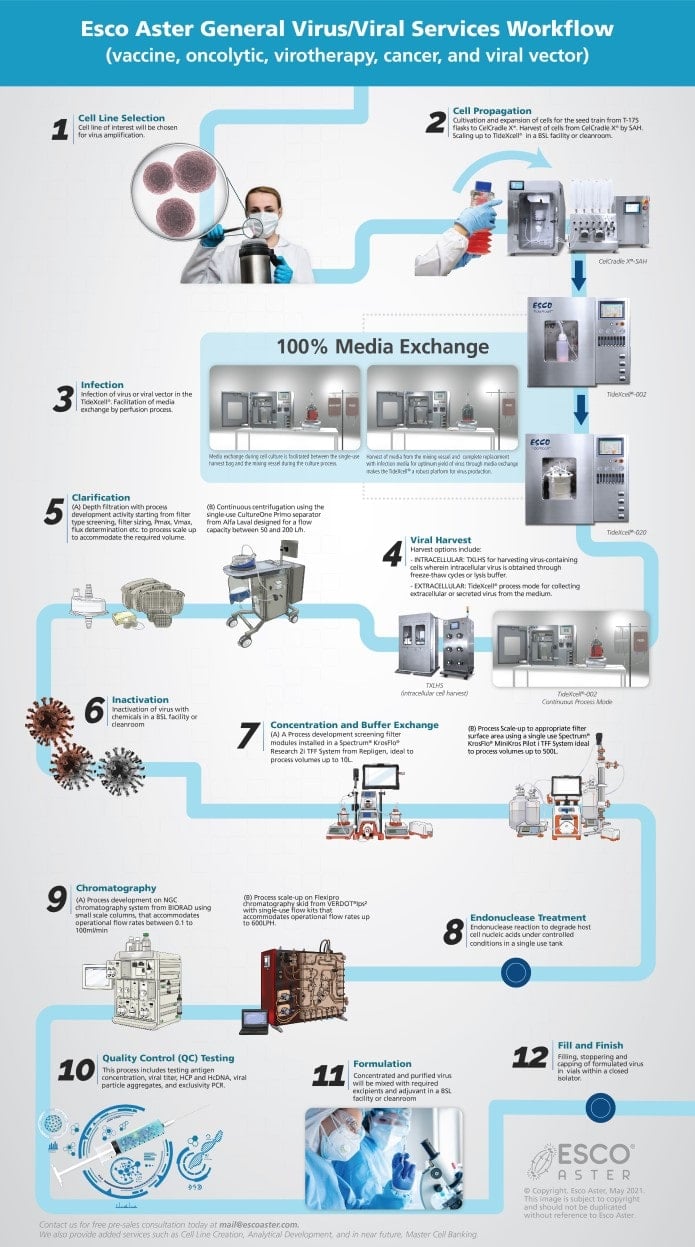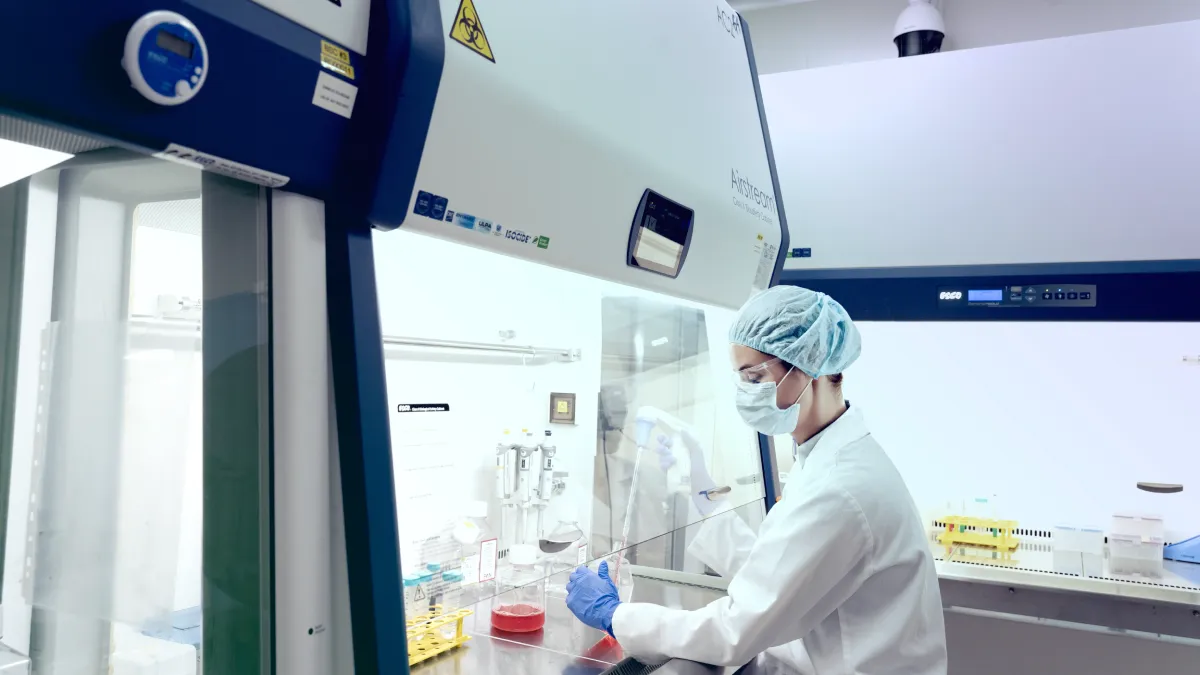Applications
Understanding the Mechanism of Gene vaccine
A genetic vaccine is a next-generation vaccine that is made by extracting a target genomic fragment from a host bacteria, virus, or even tumor cell. A bacterial plasmid is injected with the DNA (as a plasmid) and RNA (as mRNA). The final vaccine product is made through the cell culture process, purification, and filling.
Genetic vaccines work on the simple premise that if a genetic fragment (DNA/RNA) is inserted into a cell, it will be translated into an antigenic protein, which will subsequently be recognized as foreign by the recipient's immune system. The immune system will promote an immune response against the pathogen and, in turn, make the recipient of the vaccine immune to the pathogen itself.
The applications of genetic vaccines are vast because they can immunize both animals and humans against viral, bacterial, parasitic, fungal, or even cancer cells. Unlike first-generation vaccines, genetic vaccines offer a lot of benefits.
- They use the DNA/RNA from an infectious host and not the host itself, thus avoiding the possibility of being infected by the organism.
- Due to the simplicity of this technology, genetic vaccines can be manufactured in a matter of a few weeks, compared to 30-40 weeks for traditional vaccines. Production costs for manufacturing can be significantly reduced.
- Since genetic vaccines do not use live or attenuated cells, transport and storage logistics are much easier.
Advantages of Gene Vaccines
DNA vaccines appear to have certain advantages over conventional vaccines. They have the ability to induce a wider range of types of immune responses.
- DNA vaccines are more economical unlike other types of vaccines. They can be produced faster and easier in large amounts.
- They do not contain infectious viruses.
- They have long-term immunoreactivity.
- They provide better vaccine conditions for storage and shipping.
- They have a stable temperature.
- They can easy stimulates and enhance the immune system
- DNA vaccines can provide no risk of infection from subunit vaccination.
- The presence of antigens from both MHC class I and class II molecules are beneficial.
- They have the ability to separate type 1 or type 2 from T-cells.
- Immune response is focused only on antigen of interest.
- Gene vaccines are more stable, easier and safer to handle.
- Gene vaccines induce protective humoral and cellular immune responses.
- Formation of a broad spectrum of vaccines from a mixture of plasmids may be possible.
Applications of Gene Vaccines
Gene vaccines for treating cancer
Cancer is one of the leading causes of death, and there are different malignancies that are treatable by conventional therapies. Thus, improving the treatments of patients with advanced cancer immunotherapies is necessary. Gene or DNA vaccines are great forms of immunotherapy. Compared to RNA or protein-based vaccines, these tumor-specific antigens can be used for a longer period of time.
Gene vaccines against other diseases
Among the diseases for which gene vaccines demonstrated their efficacy were anthrax, HIV, tuberculosis, influenza, malaria, and dengue. In the field of gene vaccination, it has been noted that there has been substantial advancement in creating gene vaccines for a period of time. Further research on these gene vaccines may help treat additional diseases like genetic disorders and others.
Gene vaccine and COVID-19
Research studies that featured the power of DNA vaccines in preventing the COVID-19 virus was a great breakthrough during the pandemic. DNA vaccines are a relatively new type of vaccine that work by introducing a small piece of the virus's genetic material, in this case, the genetic code for the spike protein on the surface of the SARS-CoV-2 virus, into cells in the body. Once the genetic material is inside the cells, they begin to produce the spike protein, which triggers an immune response and leads to the production of antibodies that can fight the virus.
Covid-19 Vaccine as an Effective DNA Vaccine
The emergence of the COVID-19 pandemic in 2020 prompted a rapid global response to develop vaccines that could prevent and control the spread of the virus. One of the most significant breakthroughs in vaccine development during the pandemic was the effectiveness of DNA vaccines in preventing COVID-19.
The COVID-19 virus cannot be treated with available vaccinations or antivirals at the time. As a result, prominent pharmaceutical companies rushed to develop the COVID-19 vaccine between 2020 and 2021.
Covid-19 Vaccine to Boost Immunity from the Virus
The COVID-19 vaccine is beneficial from a preventive and long-term perspective since it aids in the development of the immune system with a low risk of adverse events while the fight against viral infection is still ongoing. In the presence of an alien invader, such as a virus, a vaccination is a biological material that prompts the body to react and manufacture antibodies. A natural protein produced by B cells in the immune system is called an antibody. Its primary method is to bind to certain regions of the virus and prevent it from entering a cell in order to combat infection or prevent an infection from turning into a disease. Subcutaneous (SC) or intramuscular (IM) injections are used to give the majority of approved vaccines.
The Race for the Most Promising Strategies to Fight New Variants of COVID-19 Virus Continues.
The need for effective public health interventions and reliable treatments that can overturn the surge of new COVID variants and cases has led to the development of several drugs as potential candidates for improving patient outcomes. With the highest hopes of treating infections at an early stage, drug repurposing, an approach for discovering novel applications for approved or investigational medications that are not covered by the initial medical indication, has been highly considered. In such cases, drugs and gene vaccines are being combined to take up all the molecules that have been dosed safely to humans to be available for a variety of screening assays. Ultimately, drug repurposing may be a cost-effective drug development technique that could be made available to treat coronavirus patients on a much quicker timescale than new therapies.

Tide Motion Bioreactors have been a game-changer in the production of COVID-19 vaccines, allowing for faster and more efficient vaccine manufacturing. The unique technology used in Tide Motion Bioreactors offers several advantages over traditional production methods, making it an attractive solution for the current global vaccine demand.
One of the key advantages of Tide Motion Bioreactors is their ability to increase productivity by up to 50%. This is achieved through the gentle motion that creates an optimal environment for cell growth and protein expression. This means that larger quantities of virus or bacteria used in the vaccine can be produced in a shorter period of time, allowing for faster vaccine manufacturing.
Additionally, Tide Motion Bioreactors are a scalable solution, meaning that they can be easily adapted to produce different vaccine volumes. This scalability makes it easier to rapidly ramp up production in response to spikes in demand, as we have seen during the COVID-19 pandemic.
Furthermore, Tide Motion Bioreactors are a cost-effective solution for vaccine production, which is particularly important for developing countries and low-income areas. The technology used in Tide Motion Bioreactors requires fewer raw materials and uses less energy compared to traditional production methods, making it a more sustainable and affordable solution for vaccine production.
In conclusion, Tide Motion Bioreactors offer a compelling solution for COVID-19 vaccine production, with faster production times, scalability, and cost-effectiveness. The use of this technology is an exciting step forward in the fight against the pandemic and holds promise for the future of vaccine production.
Resources
- Harvard College Global Health Review. 2021. “DNA Vaccines: Scientific and Ethical Barriers to the Vaccines of the Future.”
https://www.hcs.harvard.edu/hghr/online/dna-vaccines/ - Genes and Immunity. 2021. Gene therapy avenues and COVID-19 vaccines. https://www.nature.com/articles/s41435-021-00136-6
- National Library of medicine. 2007. DNA and RNA-based vaccines: principles, progress and prospects. https://www.ncbi.nlm.nih.gov/pmc/articles/PMC1986720/





